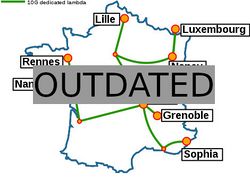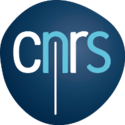Grid5000:Home: Difference between revisions
No edit summary |
No edit summary |
||
| (One intermediate revision by one other user not shown) | |||
| Line 7: | Line 7: | ||
Key features: | Key features: | ||
* provides '''access to a large amount of resources''': | * provides '''access to a large amount of resources''': 15000 cores, 800 compute-nodes grouped in homogeneous clusters, and featuring various technologies: PMEM, GPU, SSD, NVMe, 10G and 25G Ethernet, Infiniband, Omni-Path | ||
* '''highly reconfigurable and controllable''': researchers can experiment with a fully customized software stack thanks to bare-metal deployment features, and can isolate their experiment at the networking layer | * '''highly reconfigurable and controllable''': researchers can experiment with a fully customized software stack thanks to bare-metal deployment features, and can isolate their experiment at the networking layer | ||
* '''advanced monitoring and measurement features for traces collection of networking and power consumption''', providing a deep understanding of experiments | * '''advanced monitoring and measurement features for traces collection of networking and power consumption''', providing a deep understanding of experiments | ||
Revision as of 00:57, 12 February 2020
|
Grid'5000 is a large-scale and flexible testbed for experiment-driven research in all areas of computer science, with a focus on parallel and distributed computing including Cloud, HPC and Big Data and AI. Key features:
Grid'5000 is merging with FIT to build the SILECS Infrastructure for Large-scale Experimental Computer Science. Read an Introduction to SILECS (April 2018)
Older documents:
|
Random pick of publications
Five random publications that benefited from Grid'5000 (at least 2777 overall):
- Elana Courtines, Georges da Costa, Patricia Stolf. CuttleBench: A benchmarking tool for comparing programming languages' performances. Toulouse 3 Paul Sabatier. 2023. hal-04610856 view on HAL pdf
- Daniel Balouek. Performance-cost trade-offs in service orchestration for edge computing. SSDBM 2024 - 36th International Conference on Scientific and Statistical Database Management, Edge Computing; Resource Management; Computing Continuum; Trade-offs; Urgent Computing, Jul 2024, Rennes, France. pp.1-4, 10.1145/3676288.3676307. hal-04775133 view on HAL pdf
- Pierre-François Gimenez, Jérôme Mengin. Learning Conditional Preference Networks: an Approach Based on the Minimum Description Length Principle. IJCAI 2024 - 33rd International Joint Conference on Artificial Intelligence, Aug 2024, Jeju, South Korea. pp.3395-3403, 10.24963/ijcai.2024/376. hal-04572196 view on HAL pdf
- Chanattan Sok, Laurent d'Orazio, Reyyan Tekin, Dimitri Tombroff. WebAssembly serverless join: A Study of its Application. International Conference on Scientific and Statistical Database Management (SSDBM), Jul 2024, Rennes France, France. pp.1-4, 10.1145/3676288.3676305. hal-04722875 view on HAL pdf
- Abir Bouaouda, Rémi Pannequin, François Charpillet, Dominique Martinez, Mohamed Boutayeb. Dynamic modeling and AI-based control of a cable-driven parallel robot. 22nd IFAC World Congress, IFAC 2023, Jul 2023, Yokohama, Japan. 10.1016/j.ifacol.2023.10.868. hal-04201285 view on HAL pdf
Latest news
Failed to load RSS feed from https://www.grid5000.fr/mediawiki/index.php?title=News&action=feed&feed=atom: Error parsing XML for RSS
Grid'5000 sites
Current funding
As from June 2008, Inria is the main contributor to Grid'5000 funding.
INRIA |
CNRS |
UniversitiesUniversité Grenoble Alpes, Grenoble INP |
Regional councilsAquitaine |


